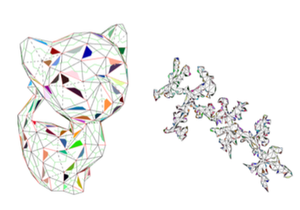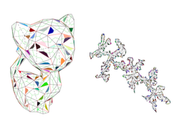Information
- Publication Type: Technical Report
- Workgroup(s)/Project(s):
- Date: May 2020
- Number: TR-193-02-2020-2
- Booktitle: CESCG
Abstract
3D Mesh unfolding is a process of transforming a 3D mesh into one or several 2D planar patches. The technique is widely used to produce papercraft models, where 3D ob- jects can be reconstructed from printed paper or paper-like materials. Nonetheless, the reconstruction of such mod- els can be arduous. In this paper, we aim to unfold a 3D mesh into a single 2D patch and introduce Gluetabs as ad- ditional indicators and in order to give users extra space to apply glue for better reconstruction quality. To avoid unnecessary Gluetabs, we reduce their number, while still guaranteeing the stability of the constructed model. To achieve this, a minimum spanning tree (MST) is used to describe possible unfoldings, whereas simulated annealing optimisation is used to find an optimal unfolding without overlaps. We aim to unfold 3D triangular meshes into sin- gle 2D patches without applying shape distortions, while appropriately assigning a reasonable amount of Gluetabs. Moreover, we incorporate a visual indicator scheme as a post-process to guide users during the model reconstruc- tion process. Our quantitative evaluation suggests that the proposed approach produces fast results for meshes under 400 faces.Additional Files and Images
Additional images and videos
Additional files
 paper:
This paper has been selected for the Best Paper Award at CESCG 2020.
paper:
This paper has been selected for the Best Paper Award at CESCG 2020.
Weblinks
No further information available.BibTeX
@techreport{korpitsch-2020-cescg,
title = "Optimising 3D Mesh Unfoldings with Additional Gluetabs using
Simulated Annealing",
author = "Thorsten Korpitsch and Hsiang-Yun Wu",
year = "2020",
abstract = "3D Mesh unfolding is a process of transforming a 3D mesh
into one or several 2D planar patches. The technique is
widely used to produce papercraft models, where 3D ob- jects
can be reconstructed from printed paper or paper-like
materials. Nonetheless, the reconstruction of such mod- els
can be arduous. In this paper, we aim to unfold a 3D mesh
into a single 2D patch and introduce Gluetabs as ad-
ditional indicators and in order to give users extra space
to apply glue for better reconstruction quality. To avoid
unnecessary Gluetabs, we reduce their number, while still
guaranteeing the stability of the constructed model. To
achieve this, a minimum spanning tree (MST) is used to
describe possible unfoldings, whereas simulated annealing
optimisation is used to find an optimal unfolding without
overlaps. We aim to unfold 3D triangular meshes into sin-
gle 2D patches without applying shape distortions, while
appropriately assigning a reasonable amount of Gluetabs.
Moreover, we incorporate a visual indicator scheme as a
post-process to guide users during the model reconstruc-
tion process. Our quantitative evaluation suggests that the
proposed approach produces fast results for meshes under 400
faces.",
month = may,
number = "TR-193-02-2020-2",
booktitle = "CESCG ",
address = "Favoritenstrasse 9-11/E193-02, A-1040 Vienna, Austria",
institution = "Research Unit of Computer Graphics, Institute of Visual
Computing and Human-Centered Technology, Faculty of
Informatics, TU Wien ",
note = "human contact: technical-report@cg.tuwien.ac.at",
URL = "https://www.cg.tuwien.ac.at/research/publications/2020/korpitsch-2020-cescg/",
}


 image
image paper
paper